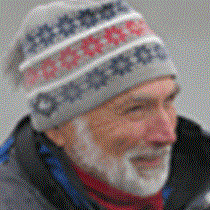Ideal Cove & Petersburg
Fog surrounded our ship as we sailed toward the anchorage of Ideal Cove. The Forest Service has built miles of boardwalks that make hiking especially easy in this area. We hiked through a beautiful temperate rainforest rich in shades of green and covered in moss. Foam flowers and five-leaved brambles poked through the carpet growing under lacey ferns and the foliage of blueberries. Higher up the leaves of fool’s huckleberry don’t seem to grow but float above the other shrubs. Everywhere large Sitka spruce and western hemlock trees give the forest a vertical dimension that towers overhead. The trail eventually leads to three lakes named Sand, Hill and Crane Lakes after the large birds that spend part of the fall and spring here during migration. About a mile and a half from the landing we found ourselves in an exquisite lake and marsh scene. Dark tannin-stained water strained through a beaver dam. The banks that gradually sloped to the water’s edge had a good representation of muskeg or bog plants. This habitat covers about ten percent of Southeast Alaska. The surface of the lake was decorated with lily pads mixed with the lance-shaped leaves of potamogeton. It was very quiet. The water was like glass. The beavers were gone.
Petersburg is the kind of town even a naturalist loves to visit. Because of the narrow passages and difficult navigation there are no large cruise ships that dock here. It is an authentic look at Southeast Alaskan life, complete with "Extra Tuff" boots pounding the sidewalks, people with smiles, commercial fishing boats galore and no sales on T-shirts. As we entered the harbor, a sea lion bull surfaced. Locals call him George. He glared at us with a sidewise look that wasn’t as congenial as the folks in town. A fisherman threw him a salmon. Although hard to believe, the catch for this community can be over 100 million dollars worth of fish a year. That fact probably explains the most about the community, even the presence of the sea lion.
Hikers set off in all directions. Some walked towards Petersburg Mountain, and others explored the world of the muskeg, walked amongst the fishing boats, or poked into the hardware store and the local museum to see what life is like here.
A special guest boarded just before we left Petersburg. Sean Hanser is a humpback whale researcher with the Alaska Whale Foundation and specializes in underwater acoustics. After dinner Sean gave a program on his work. He is such a good speaker and the life of humpback whales is so interesting our attention became riveted to his discussion. Acoustical studies are another window into interpreting so much that is still unknown about these creatures. He discussed cutting edge research and shared many of the new ideas.
After his presentation we were lucky to find a lone humpback whale. With a bit more knowledge of their lives we were entertained until darkness settled in around us.
Fog surrounded our ship as we sailed toward the anchorage of Ideal Cove. The Forest Service has built miles of boardwalks that make hiking especially easy in this area. We hiked through a beautiful temperate rainforest rich in shades of green and covered in moss. Foam flowers and five-leaved brambles poked through the carpet growing under lacey ferns and the foliage of blueberries. Higher up the leaves of fool’s huckleberry don’t seem to grow but float above the other shrubs. Everywhere large Sitka spruce and western hemlock trees give the forest a vertical dimension that towers overhead. The trail eventually leads to three lakes named Sand, Hill and Crane Lakes after the large birds that spend part of the fall and spring here during migration. About a mile and a half from the landing we found ourselves in an exquisite lake and marsh scene. Dark tannin-stained water strained through a beaver dam. The banks that gradually sloped to the water’s edge had a good representation of muskeg or bog plants. This habitat covers about ten percent of Southeast Alaska. The surface of the lake was decorated with lily pads mixed with the lance-shaped leaves of potamogeton. It was very quiet. The water was like glass. The beavers were gone.
Petersburg is the kind of town even a naturalist loves to visit. Because of the narrow passages and difficult navigation there are no large cruise ships that dock here. It is an authentic look at Southeast Alaskan life, complete with "Extra Tuff" boots pounding the sidewalks, people with smiles, commercial fishing boats galore and no sales on T-shirts. As we entered the harbor, a sea lion bull surfaced. Locals call him George. He glared at us with a sidewise look that wasn’t as congenial as the folks in town. A fisherman threw him a salmon. Although hard to believe, the catch for this community can be over 100 million dollars worth of fish a year. That fact probably explains the most about the community, even the presence of the sea lion.
Hikers set off in all directions. Some walked towards Petersburg Mountain, and others explored the world of the muskeg, walked amongst the fishing boats, or poked into the hardware store and the local museum to see what life is like here.
A special guest boarded just before we left Petersburg. Sean Hanser is a humpback whale researcher with the Alaska Whale Foundation and specializes in underwater acoustics. After dinner Sean gave a program on his work. He is such a good speaker and the life of humpback whales is so interesting our attention became riveted to his discussion. Acoustical studies are another window into interpreting so much that is still unknown about these creatures. He discussed cutting edge research and shared many of the new ideas.
After his presentation we were lucky to find a lone humpback whale. With a bit more knowledge of their lives we were entertained until darkness settled in around us.




